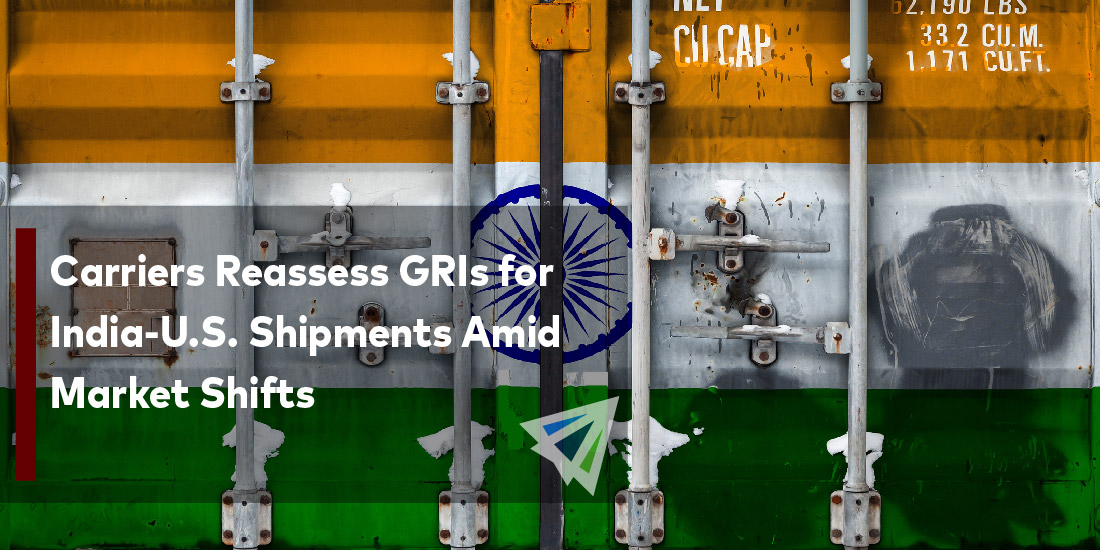Carriers are reevaluating their strategy more often as the world’s shipping market continues to fluctuate. This is especially true with regard to General Rate Increases (GRIs) for the India-U.S. trade route. Shipping lines have been hesitant to apply rate increases in the face of a changing market since it has shown to be more resilient than expected.
The Role of GRIs
The Indian subcontinent has served as a hub for global trade, with considerable activity occurring on the sea routes connecting India to the East and Gulf Coasts of the United States. Carriers have always relied on GRIs to control demand and keep a profit. Usually, these rate changes are planned for when demand is at its highest. But recent changes in the market have forced a review of these strategies.
CMA CGM, a significant participant in this trade channel, has repeatedly delayed the application of its Peak Season Surcharge (PSS), with the most recent delay moving the date forward to October 1. The surcharge, which was originally scheduled for August, has now been lowered to $1,000 per container from its original $1,500 value. The carrier’s response to the changing market conditions and its attempt to maintain its competitiveness while averting possible shipper backlash are reflected in this modification.
In a similar vein, Hapag-Lloyd, another important carrier in this trade, has set October 1 as the date of a $1,000 per container GRI. The German shipping company has informed us that this change will be effective immediately for all gated containers and will last indefinitely. The cautious stance taken by Hapag-Lloyd and CMA CGM highlights the wider level of market uncertainty.
Changes in the Market and Adjustments to Rates
With freight costs from India to North America dropping, the decision was made to delay and lower surcharges. After reaching a peak in July of approximately $10,000 per 40-foot container, rates have sharply declined since mid-August. The decline in demand is ascribed to multiple factors, such as the conclusion of the customary high season and the effect of cancelled sailings on West India-U.S. East Coast routes.
According to freight forwarders, rates will drop further and stabilize by mid-September, hovering around $4,000 and $5,000 per 40-foot equivalent unit (FEU). The lower rates are a result of more weekly capacity leaving important Indian ports like Mundra and Nhava Sheva. This capacity expansion comes after CMA CGM and Hapag-Lloyd dissolved their long-running joint Indamex services and started their own loops to better suit the changing market.
Operational Difficulties During Expansion
Even though the number of containers has increased overall, the Indian shipping sector has encountered operational difficulties. Due to the recent floods at the port of Mundra, operations were temporarily suspended, which resulted in delays to vessel schedules and backlogs of containers. Due to these disruptions, shippers are worried about possible cargo rollovers, which might exacerbate the market’s already unstable conditions.
Nevertheless, container volumes have increased significantly in the fiscal year 2024–2025. India’s containerized trade reached 2.2 million TEUs in August alone, a 16% month-over-month increase. At PSA Mumbai (BMCT) in Nhava Sheva, which achieved a throughput milestone of 200,000 TEUs in a single month, this expansion has been especially noteworthy. This accomplishment demonstrates the Indian port industry’s tenacity in the face of shifting demand and practical difficulties.
The More Comprehensive Economic Framework
India’s export industry has been more significantly impacted by the recent increase in ocean freight rates. After a period of stable expansion, national merchandise exports by value decreased by 1% year over year in July. Due to the prolonged shipping difficulties and the sudden spike in freight charges, some exporters are now concentrating on the home market. The Federation of Indian Export Organizations’ President, Ashwani Kumar, claims that the high cost of international shipping by air and water has negatively impacted export profitability.
Forward-Looking: Strategic Modifications
Carriers’ approach to rate modifications will need to stay flexible as the market develops. The recent changes in the trade channel between the United States and India highlight the value of adaptability in negotiating a complicated and dynamic global maritime environment. While there may be more freight rate reductions in the near future, carriers’ ability to adjust to changing demand patterns and operational difficulties will determine their prospects in the long run.
In summary, the reevaluation of GRIs by large carriers like CMA CGM and Hapag-Lloyd indicates a cautious strategy for overseeing the commerce lane between India and the United States. Carriers will need to strike a balance between profitability and the requirement to be competitive in a dynamic industry as the market stabilizes and demand returns to normal. The course of this vital trade route will be determined in large part by events that occur in the upcoming months.
InterlogUSA continues to stay up to date on this and the latest in the market, to provide our customers and readers with the latest industry news. Should you have any questions regarding this, please reach out to our team today.
Additionally, we have weekly market updates that provide relevant freight news, updates, developments across the industry, and more.
